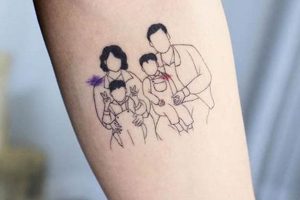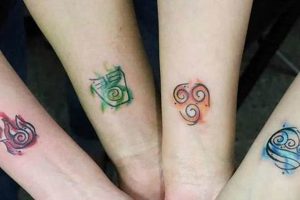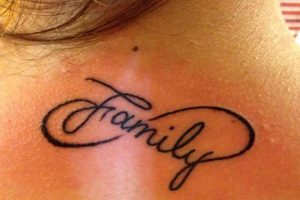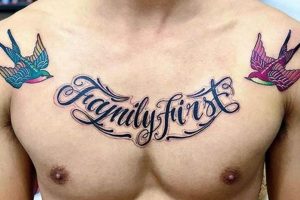Leg tattoos offer a prominent yet concealable canvas for meaningful artwork, making them a popular choice for designs centered around family. These designs can range from simple symbolic representations, such as birthdates or initials, to complex portraits or scenes depicting shared memories and values. Examples include a family tree extending down the calf, a collection of birth flowers representing each member, or a quote signifying familial bonds.
Permanent body art serves as a powerful expression of personal identity and connection. Choosing to showcase familial devotion through a leg tattoo reflects the enduring importance of these relationships. The placement on the leg allows for both personal reflection and public display, depending on attire. Historically, tattoos have symbolized belonging and commemoration across numerous cultures, and contemporary leg tattoos focused on family continue this tradition in a modern aesthetic.
Various factors contribute to the design process, including stylistic preferences, symbolic elements, and the overall composition on the leg. Exploring these elements will offer a deeper understanding of how to create meaningful and visually appealing leg tattoos that honor familial bonds.
Tips for Leg Tattoos Focused on Family
Careful planning ensures a leg tattoo becomes a cherished tribute to family. Consider these suggestions before committing to a design.
Tip 1: Consider Placement and Size. The leg offers diverse areas calf, thigh, ankle each affecting the visual impact and pain level. Larger pieces suit the thigh, while smaller, intricate designs fit well on the ankle or calf. Placement also dictates visibility and ease of concealment.
Tip 2: Choose Meaningful Symbolism. Rather than just names, explore symbols reflecting shared experiences or values. Birthstones, meaningful quotes, or shared hobbies can create a more personalized and resonant design.
Tip 3: Research Artists Specializing in the Desired Style. Tattoo styles vary significantly, from realism to traditional to minimalist. Review portfolios to find an artist whose expertise aligns with the envisioned aesthetic.
Tip 4: Plan for Multiple Sessions for Complex Designs. Intricate tattoos involving portraits or extensive detail may require multiple sessions to complete. This allows for proper healing and meticulous execution.
Tip 5: Prioritize Aftercare. Proper aftercare is crucial for preserving the vibrancy and longevity of the tattoo. Follow the artists instructions diligently to prevent infection and ensure proper healing.
Tip 6: Reflect on the Design’s Longevity. Tattoos are permanent. Ensure the chosen design remains meaningful over time and consider how lifestyle changes might impact its appearance.
Tip 7: Explore Black and Gray vs. Color. Consider the desired visual impact. Black and gray offer a timeless, classic aesthetic, while color can add vibrancy and personality. Skin tone can also influence color choices.
Thoughtful planning and execution result in a beautiful and enduring tribute to familial bonds. These tips facilitate informed decisions, ensuring a leg tattoo serves as a lasting source of personal significance.
By following these guidelines, individuals can embark on the process of creating a leg tattoo that not only honors family but also becomes a cherished piece of personal art.
1. Placement (thigh, calf, ankle)
Placement significantly influences the aesthetic and practical aspects of family-themed leg tattoos. The thigh provides ample space for larger, more detailed designs, such as intricate family portraits or expansive nature scenes incorporating symbolic elements. Its larger surface area allows for greater artistic expression and accommodates designs with multiple figures or elements. Conversely, the calf offers a balance between visibility and concealability, suitable for medium-sized designs like family trees or interwoven initials. Its curved shape can be incorporated into the design, adding an element of flow and dynamism. The ankle, being a smaller and more delicate area, lends itself well to minimalist designs small symbols, dates, or single names. Its visibility makes it ideal for showcasing particularly meaningful elements.
Choosing the appropriate placement requires careful consideration of the design’s size, complexity, and intended visibility. A sprawling family crest might overwhelm the ankle, while a small, single initial would appear lost on the vast expanse of the thigh. Practical considerations also come into play. The thigh generally offers a less painful tattooing experience due to increased muscle mass and fewer nerve endings, while the ankle and calf, being closer to bone, can be more sensitive. Placement also impacts how easily a tattoo can be concealed or displayed, depending on individual preferences and social contexts.
Strategic placement enhances the overall impact of a family-themed leg tattoo. Careful consideration of size, visibility, and the anatomical contours of the leg ensures a harmonious and aesthetically pleasing result. The chosen location can subtly amplify the design’s meaning, creating a deeply personal and visually striking tribute to familial bonds.
2. Style (realism, traditional)
The chosen artistic style significantly impacts the visual representation of family-themed leg tattoos. Different styles evoke distinct emotions and convey varying levels of detail, influencing the overall message and aesthetic. Selecting a style that resonates with personal preferences and complements the chosen design elements is essential for a successful and meaningful tattoo.
- Realism
Realism focuses on accurate and detailed depictions, often resembling photographs. This style excels in portrait tattoos, capturing the likeness of family members with striking precision. The level of detail requires a skilled artist specializing in realism. Realism lends itself well to larger pieces on the thigh or calf, providing sufficient space for intricate features and shading. However, realistic portraits can require more frequent touch-ups over time to maintain clarity as the ink ages.
- Traditional (American Traditional/Neo-Traditional)
Traditional styles employ bold lines, vibrant colors, and iconic imagery. This style often incorporates symbolic elements like anchors, hearts, and flowers, which can be adapted to represent family connections. Traditional tattoos possess a timeless quality and tend to age well due to their strong lines and solid color saturation. Neo-traditional builds upon this foundation, incorporating modern elements and a broader color palette, offering greater flexibility for personalized designs.
- Watercolor
The watercolor style mimics the fluid and translucent nature of watercolor paintings. This approach offers a softer, more artistic representation of family themes, ideal for capturing abstract concepts or emotions. While visually striking, watercolor tattoos can be more susceptible to fading over time due to their delicate nature and reliance on subtle shading. Careful placement and diligent aftercare are crucial for preserving their longevity.
- Minimalism/Linework
Minimalist and linework styles prioritize simplicity and clean lines. Small, symbolic designs, such as initials, birthdates, or outlines of significant objects, convey deep meaning with understated elegance. This style suits smaller placements like the ankle or inner calf. Its simplicity translates to shorter tattoo sessions and typically involves less discomfort. The clean lines tend to age well, requiring minimal touch-ups.
The interplay between style and subject matter elevates family-themed leg tattoos from mere body art to powerful expressions of personal connection. Selecting the appropriate style enhances the intended message and ensures the tattoo resonates with personal aesthetics and values. By considering the strengths and limitations of each style, individuals can create a lasting tribute that honors family bonds in a visually compelling and meaningful way.
3. Symbolism (portraits, quotes)
Symbolism forms the heart of meaningful family-themed leg tattoos, transforming simple designs into powerful expressions of love, connection, and remembrance. Portraits, quotes, and other symbolic representations imbue the tattoo with personal significance, narrating familial stories and shared values. The choice of symbolism reflects the unique dynamics and history of each family, creating a deeply personal and lasting tribute.
Portraits capture the essence of loved ones, preserving their likeness in a permanent and intimate way. A detailed portrait of a parent, grandparent, or child serves as a constant reminder of their presence and importance. Alternatively, a portrait of a beloved family pet can commemorate a cherished member of the family unit. Symbolic imagery further enhances personal meaning. Incorporating elements such as birth flowers, meaningful objects, or shared hobbies weaves a richer narrative into the tattoo’s design. For instance, a compass can represent shared journeys, while interlocking trees symbolize deep-rooted connections. Quotes, whether from literary works, songs, or personal exchanges, encapsulate shared values or cherished memories. A meaningful phrase or saying acts as a permanent inscription of familial love and understanding, resonating with both the wearer and those who recognize its significance. Choosing a quote in a loved one’s handwriting adds a further layer of personalization.
The selection of appropriate symbolism requires careful consideration of individual family histories and shared experiences. The most impactful symbols often emerge from deeply personal narratives, reflecting specific memories, inside jokes, or defining moments. The ultimate goal is to create a visual representation that authentically reflects the unique bond within a family. This thoughtful approach to symbolism elevates the tattoo beyond mere aesthetics, transforming it into a powerful and enduring testament to familial love and connection.
4. Size and scale
Size and scale play a crucial role in the overall impact and effectiveness of family-themed leg tattoos. The chosen dimensions must complement both the design’s complexity and the available canvas on the leg. A small, intricate design might appear lost on the thigh, while a large, detailed portrait could overwhelm the ankle. Careful consideration of size and scale ensures the tattoo remains balanced, legible, and aesthetically pleasing.
Larger-scale tattoos offer greater scope for intricate detail and complex compositions. A sprawling family tree, incorporating names, dates, and symbolic imagery, requires the ample space afforded by the thigh. Similarly, realistic portraits benefit from larger dimensions, allowing for nuanced shading and lifelike representation. Conversely, smaller tattoos often rely on symbolic representation and minimalist aesthetics. A small cluster of birth flowers on the ankle can convey deep meaning without requiring extensive space. Single initials, meaningful dates, or small geometric patterns also suit smaller scales, offering a subtle yet powerful tribute to family. The interplay between size and placement also influences the tattoo’s visibility and how easily it can be concealed. A large tattoo on the calf will be more readily visible than a small design on the inner thigh. These factors influence clothing choices and social contexts where visibility might be a consideration.
Balancing size and scale with design complexity and placement ensures the leg tattoo effectively communicates its intended message. A well-proportioned tattoo, regardless of size, harmonizes with the contours of the leg and complements the individual’s physique. Thoughtful consideration of these factors results in a visually appealing and meaningful piece of body art that serves as a lasting tribute to familial bonds.
5. Color palette (vibrant, muted)
Color palettes significantly influence the mood and impact of family-themed leg tattoos. Vibrant colors evoke feelings of joy, energy, and celebration, while muted tones convey a sense of serenity, reflection, and timelessness. The chosen palette should harmonize with the overall design and reflect the intended emotional message. A vibrant palette featuring primary colors might suit a playful design incorporating children’s birthstones, whereas a muted palette of earth tones could complement a memorial tattoo honoring a deceased relative. Skin tone also plays a vital role; certain colors appear more vibrant on darker skin, while others might fade or lose contrast.
Consider a family tree tattoo extending down the calf. Using autumnal huesburnt oranges, deep reds, and golden yellowscould symbolize the passage of time and the enduring strength of familial roots. Conversely, a tattoo featuring a family of birds in flight might benefit from a vibrant palette of blues, greens, and yellows, representing freedom, growth, and shared journeys. Practical considerations also come into play. Vibrant colors, while initially striking, can fade more quickly than muted tones, particularly with frequent sun exposure. Black and gray offer a classic, timeless option, less susceptible to fading and requiring fewer touch-ups over time. These palettes provide a strong foundation for intricate details and shading, ensuring the design’s longevity and visual impact.
Careful color selection enhances the emotional resonance and longevity of family-themed leg tattoos. Harmonizing the color palette with the design’s theme and the individual’s skin tone creates a cohesive and visually appealing result. Understanding the practical implications of different color choices, particularly regarding fading and longevity, ensures the tattoo remains a meaningful and aesthetically pleasing tribute for years to come.
6. Artist Selection
Artist selection represents a crucial step in realizing family-themed leg tattoo ideas. A skilled artist translates personal visions into permanent artwork, ensuring the final result aligns with expectations and stands the test of time. Technical expertise, artistic style, and a collaborative approach contribute significantly to a successful tattoo experience. Choosing an artist specializing in the desired stylerealism, traditional, watercolor, or minimalismensures the final product accurately reflects the intended aesthetic. A mismatch between artistic style and the envisioned design can lead to disappointment, compromising the tattoo’s overall impact. For instance, commissioning a photorealistic portrait from an artist specializing in geometric linework would likely yield unsatisfactory results.
Beyond technical skill, an artist’s portfolio offers valuable insights into their capabilities and artistic sensibilities. Reviewing previous work allows individuals to assess the artist’s proficiency in specific techniques, such as portraiture, lettering, or color blending. Examples of family-themed tattoos within their portfolio demonstrate direct experience and understanding of the desired subject matter. This targeted approach streamlines the selection process, increasing the likelihood of a positive outcome. Practical considerations, such as hygiene standards and studio reputation, should also inform the decision-making process. A reputable artist adheres to strict sterilization protocols, ensuring a safe and hygienic tattooing environment. Client testimonials and online reviews provide additional insights into the artist’s professionalism and overall client experience.
Effective communication between the client and artist underpins a successful collaboration. Clearly articulating design preferences, symbolic meanings, and placement considerations ensures a shared understanding. A collaborative approach, characterized by open dialogue and constructive feedback, facilitates the creation of a tattoo that resonates with the client’s vision. This collaborative process transforms abstract ideas into tangible artwork, resulting in a meaningful and enduring tribute to family. Ultimately, meticulous artist selection ensures the final product embodies the intended emotional significance, becoming a cherished piece of personal art that reflects both familial bonds and artistic excellence.
Frequently Asked Questions
Addressing common inquiries regarding family-themed leg tattoos provides clarity and facilitates informed decision-making. These responses offer practical guidance and dispel potential misconceptions.
Question 1: How much do family leg tattoos typically cost?
Pricing varies based on size, complexity, artist experience, and geographical location. Larger, more intricate designs requiring multiple sessions naturally incur higher costs. Consulting with several artists allows for cost comparisons and ensures alignment with budgetary constraints.
Question 2: What factors influence pain levels during the tattooing process?
Placement significantly impacts pain levels. Areas with thinner skin and closer proximity to bone, such as the ankle and shin, tend to be more sensitive. Individual pain tolerance also varies. Discussing pain management strategies with the chosen artist can alleviate discomfort during the procedure.
Question 3: How long does the healing process typically take?
Healing generally requires 2-4 weeks. Factors such as individual healing rates, tattoo size, and adherence to aftercare instructions influence the overall healing time. Following the artist’s aftercare guidelines diligently promotes proper healing and minimizes potential complications.
Question 4: What design elements are most suitable for long-term satisfaction?
Meaningful symbolism and timeless aesthetics contribute to long-term satisfaction. Focusing on designs that hold personal significance and avoiding trendy elements ensures the tattoo remains relevant and cherished over time.
Question 5: Can family leg tattoos be modified or covered up in the future?
Modification or cover-up options depend on the existing tattoo’s size, color saturation, and placement. Cover-ups require larger designs incorporating the existing tattoo elements. Laser removal can lighten or partially remove the tattoo, facilitating cover-up options. Consulting with an experienced artist provides tailored solutions based on individual circumstances.
Question 6: How does sun exposure affect leg tattoos over time?
Sun exposure can cause fading and color distortion over time. Protecting the tattoo with sunscreen, especially during prolonged sun exposure, helps maintain its vibrancy and longevity. Higher SPF sunscreens offer greater protection and minimize UV damage.
Careful consideration of these factors contributes to a positive tattoo experience and ensures the chosen design remains a source of pride and personal significance for years to come. Thorough research and open communication with the chosen artist address potential concerns and facilitate informed decision-making.
By understanding the process, costs, and long-term implications, individuals can embark on their tattoo journey with confidence, creating a lasting tribute to familial bonds.
Family Leg Tattoo Ideas
Exploring the nuances of family-themed leg tattoos reveals the potential for profound personal expression. Careful consideration of placement, style, symbolism, size, color palette, and artist selection ensures a harmonious and meaningful result. From realistic portraits capturing individual likenesses to symbolic representations of shared values, leg tattoos offer a powerful canvas for commemorating familial bonds. Understanding the practical aspects, including cost, pain management, healing, and long-term care, empowers individuals to make informed decisions.
Leg tattoos dedicated to family transcend mere aesthetics; they embody enduring connections, shared histories, and the profound impact of familial relationships. Thoughtful planning and execution transform these designs into lasting tributes, etched not only onto skin but also into the tapestry of personal narratives. The commitment to permanent body art reflects the enduring power of family, serving as a constant reminder of love, loyalty, and the indelible mark of shared experiences.







